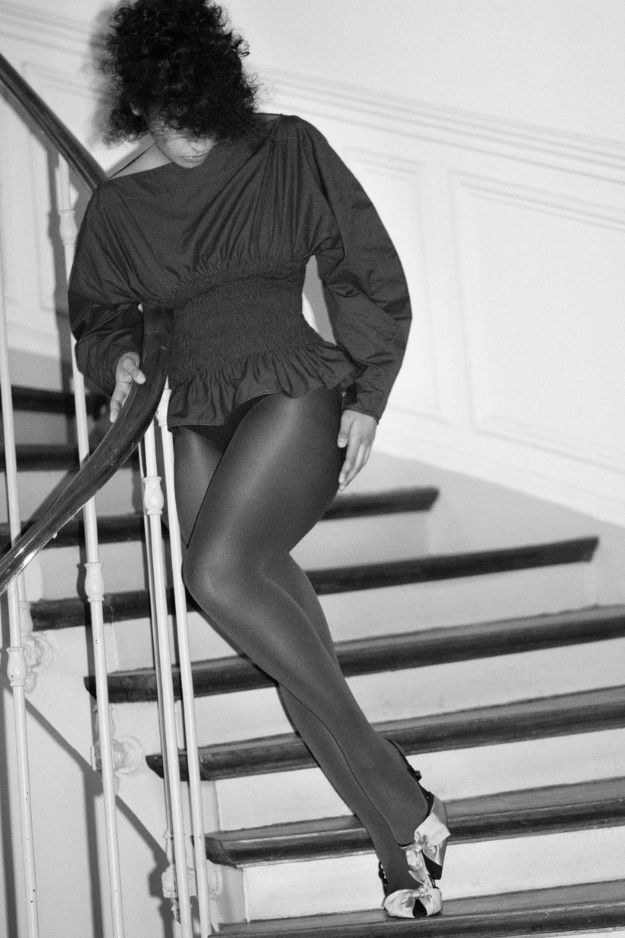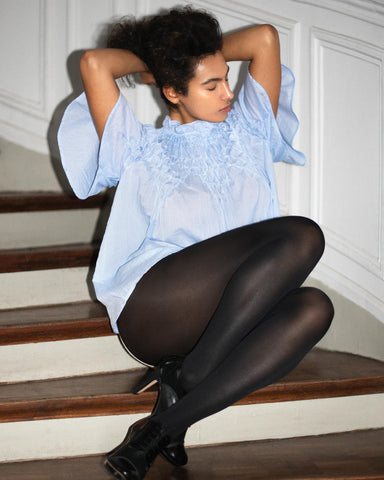In Motion with Kenza Safsaf

What happens when a model goes behind the camera? In the case of French model and photographer Kenza Safsaf, it’s inspiring imagery that includes references from the ancient to mid-century to very much right now. Kenza turned her lens on herself for a series of self portraits in the Merlette Pre Spring 2024 collection, and we got to chat with her about the shoot, her style and her work.
Q: Where do you get the inspiration for your shoots? What inspired your shoot for Merlette?
A: A lot of unexpected and fun content from the internet ends up on my moodboards. Sometimes the most random things & moments kindle my creativity. I think it helps keeping my work playful.
Right now, I’m very into the 1960’s glamour and daintiness and neoclassic sculptures but I always try to bring a modern touch to my often-old references.
I’d say I approached the shoot essentially with movement. Merlette clothes have a strong identity already so I wanted the styling to stay very simple and essential and just add what I think is most typical about my work — movement.
Q: As a female creative, what does it mean to you to work with female- founded brands?
A: It’s very gratifying to collaborate with a brand like Merlette with a genuine approach to design and imagery. And it happens to be a female founded brand which is even better! I believe in women supporting each other to create a world where our gender isn’t an obstacle anymore.
Q: How does shooting self-portraiture differ for you than shooting others?
A: Photographing myself is very liberating but it can also be very challenging compared to shooting others. I gain control but lose some of it as well. I am still working on the process in order to get more efficient.
Directing myself comes naturally, I can execute my vision instantly, when shooting others I obviously need to vocalize my ideas which aren’t always easy to translate. I learnt how to push my mind and body further in order to reach higher levels of creativity when shooting myself, with others it’s sometimes challenging to convince them to forget themselves and to play along. It requires some good communication skills and even using some psychology.
Q: How does your work as a model affect your approach to photography?
A: Modeling has taught me the industry codes which is a very good starting point when you want to get on the other side of the camera, be at the heart of the creative process.
On set, as a model, you usually have quite the free time. I just used mine observing dynamics to understand how we create a fashion image. That was very educational. I also got to work with inspiring creatives who made me discover a variety of universes that I often reference now.
My experience also makes me more empathic with the models that I photograph. I get them, we pretty much all went through the same things and I know how vulnerable it can be standing in front of a camera. I believe that makes me able to install a favorable atmosphere to then create. It’s a win for them (I hope) and a win for me!
Q: How would you describe your style?
A: I think for a creative to define their own style is a difficult task. Personally, I feel like I tend to describe the direction I want to take rather than my already existing work.A friend of mine says that “Taste is a prison.” I say it too now and I think style might be as well.
So I would say that I aim to create a cerebral universe yet playful, hopefully timeless that is also a testimony of our time’s aesthetics. All that led by a slightly disruptive or uncommon association of movements, fashion, beauty and light.
In order to do that, I believe in teamwork, the unity of passionate talents to create the dream (as in “team work makes the dream work”) but challenge it as well. I don’t want to settle too much into an aesthetic or habits and risk losing the fun and even the relevancy in my work.









